
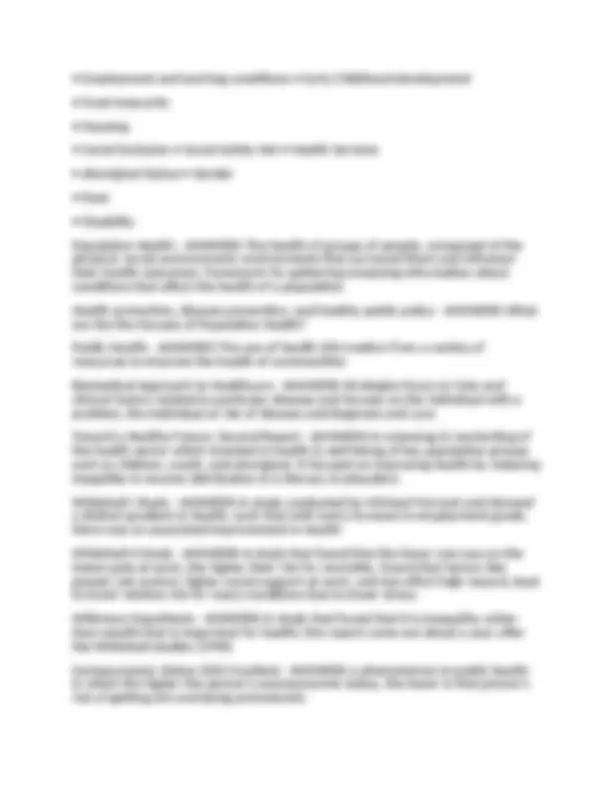
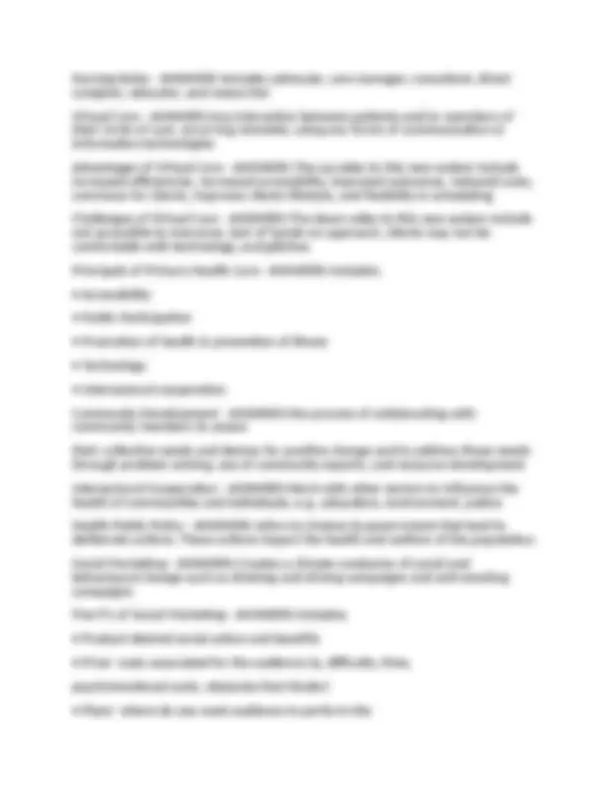
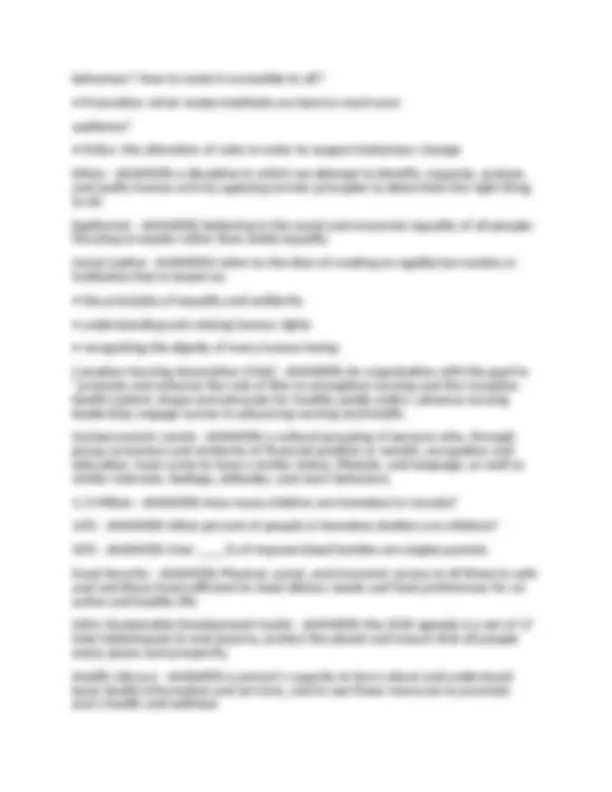
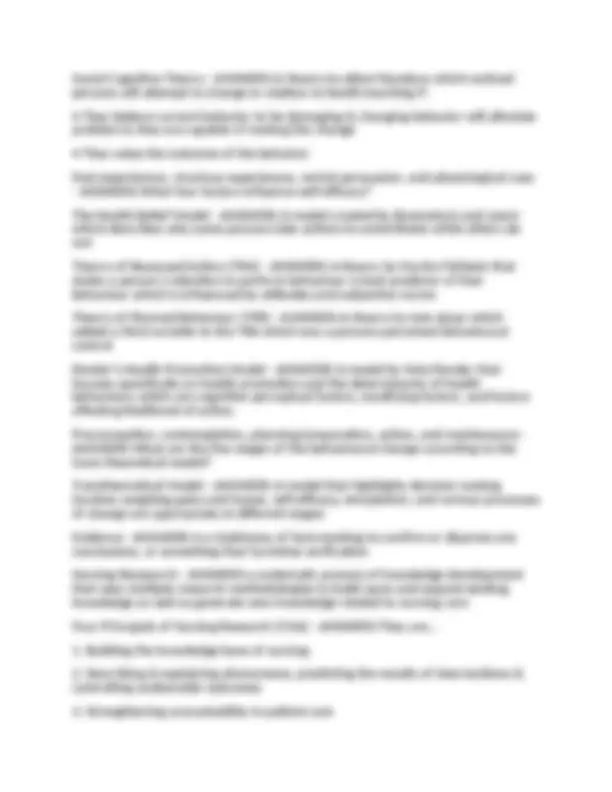
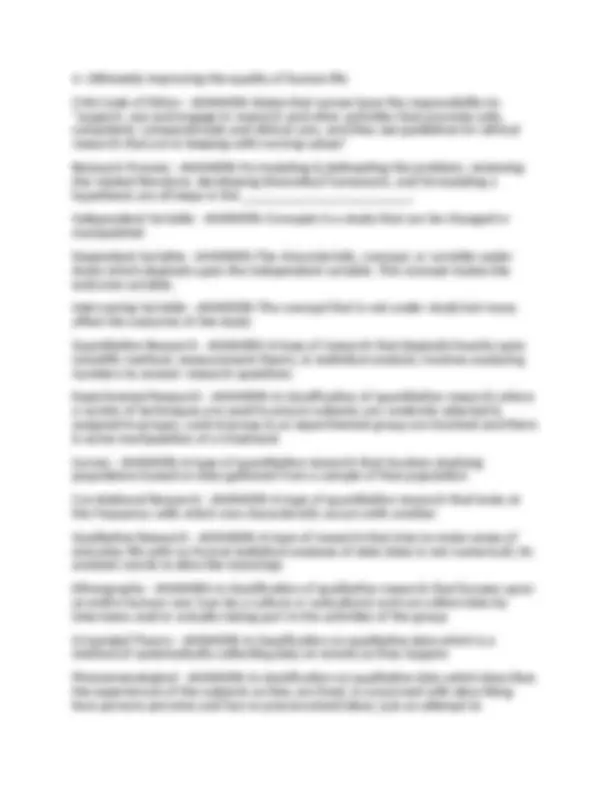
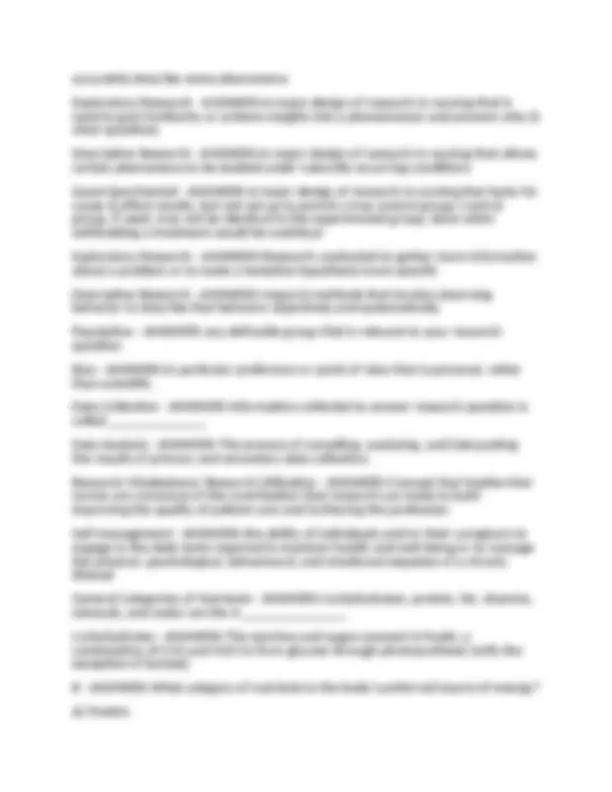
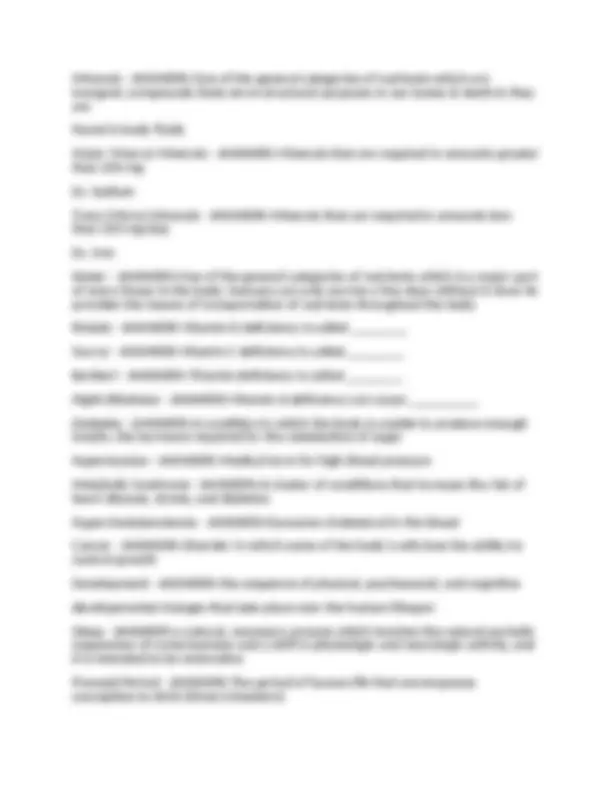
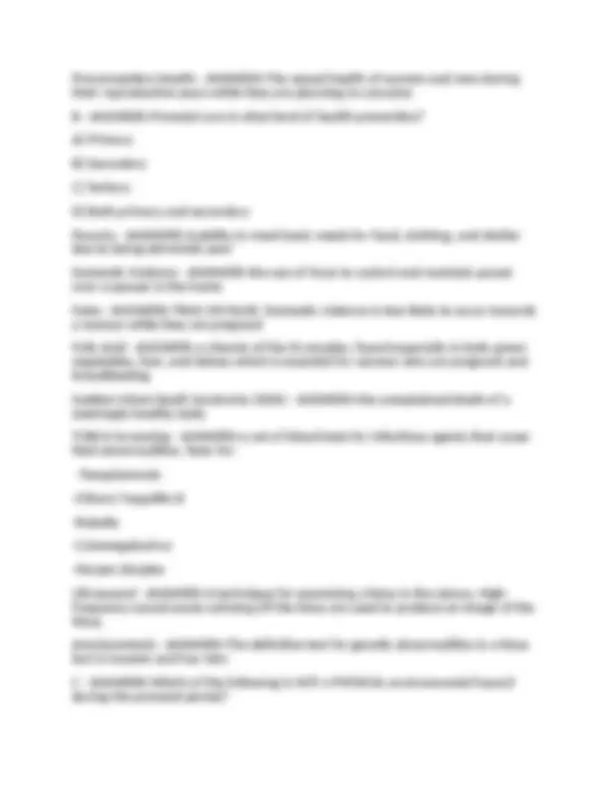
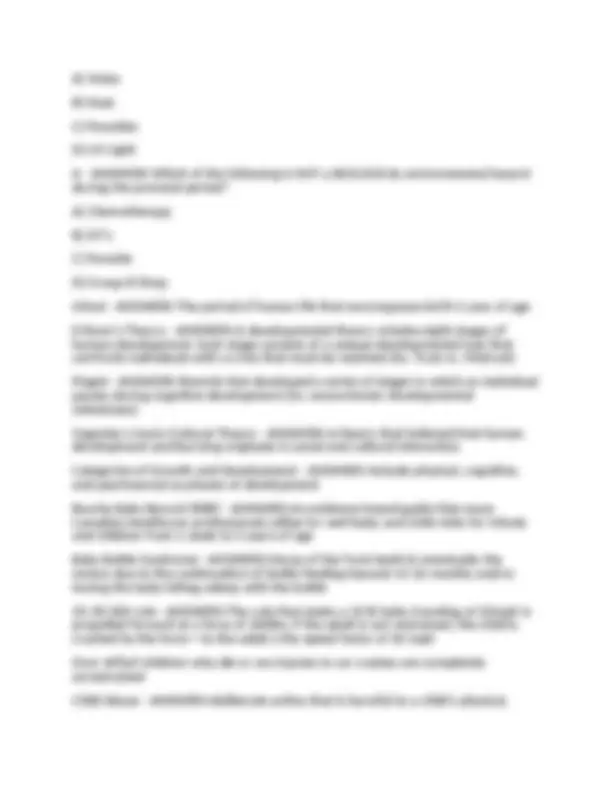
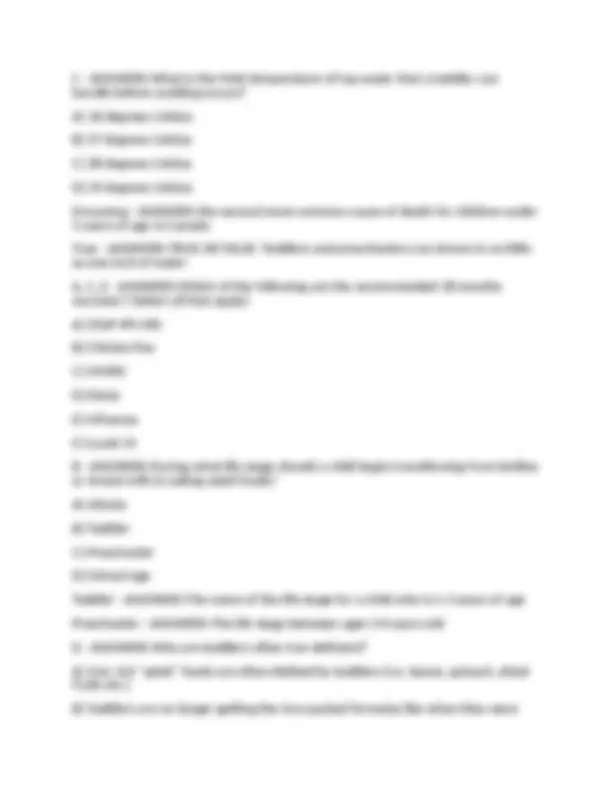
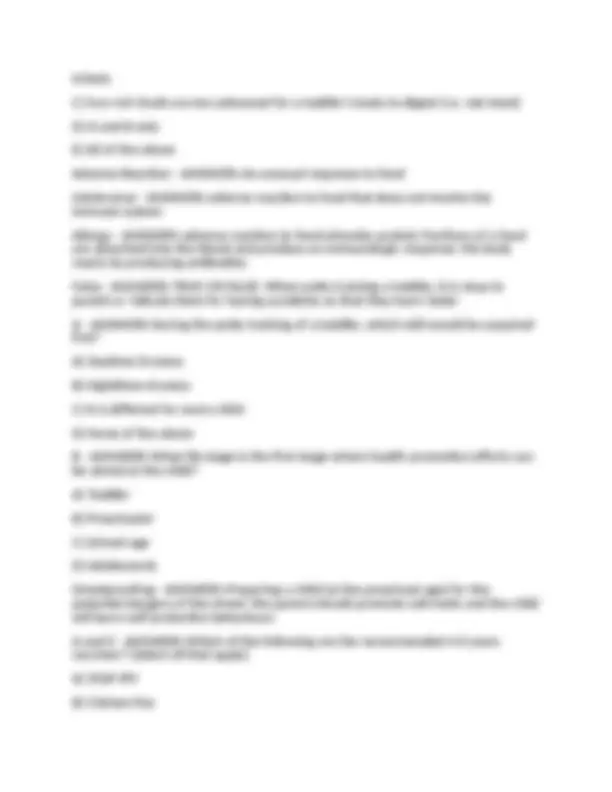
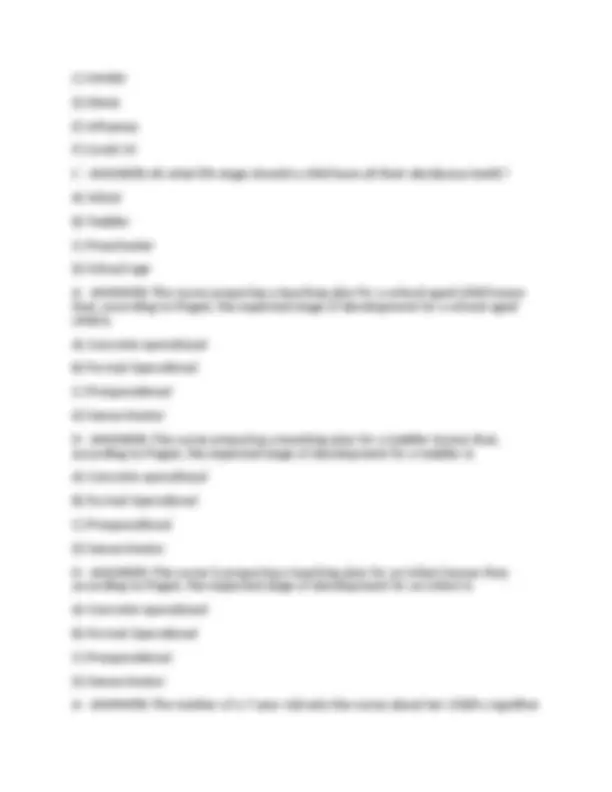
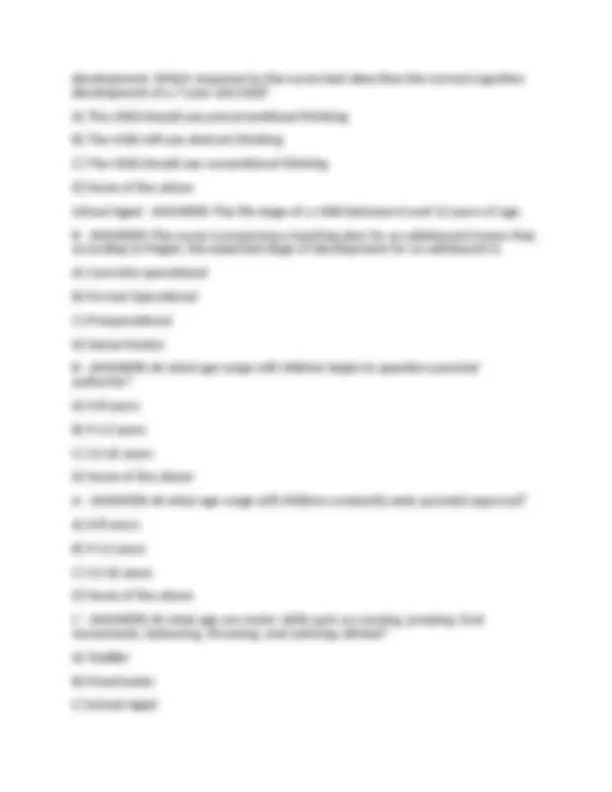
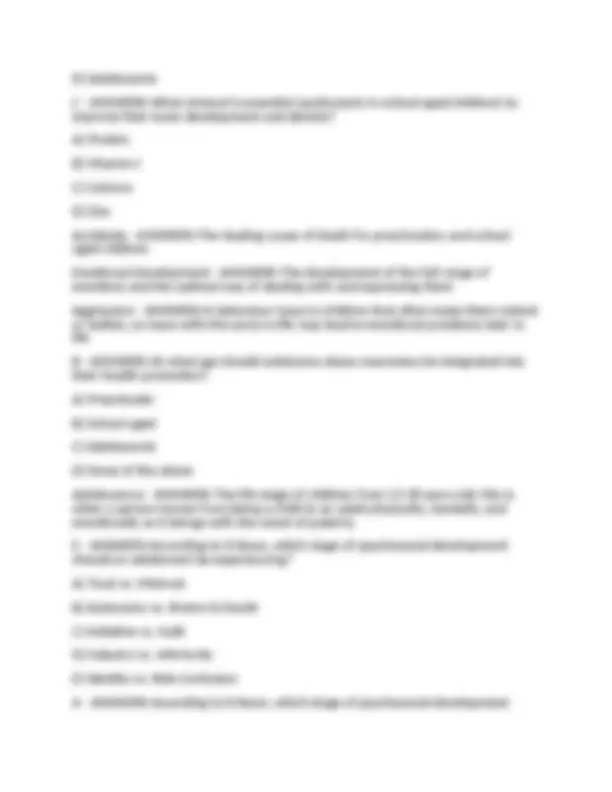
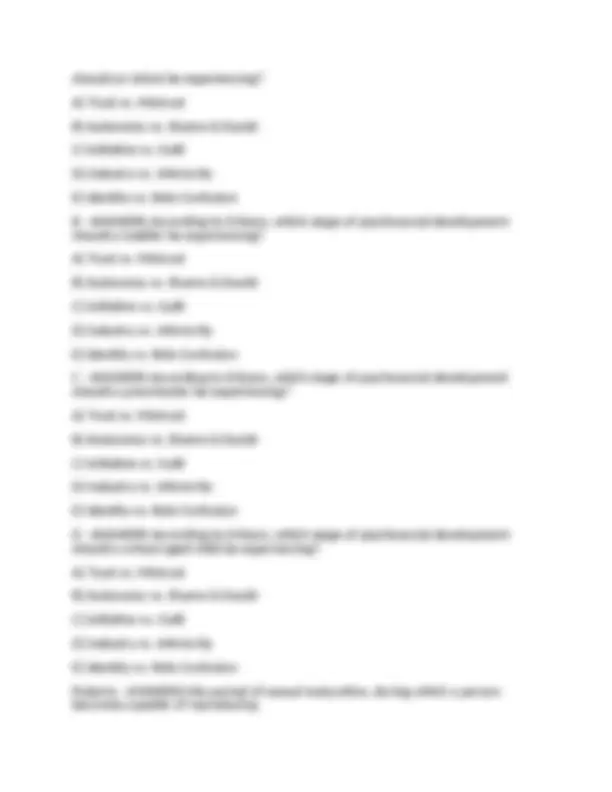
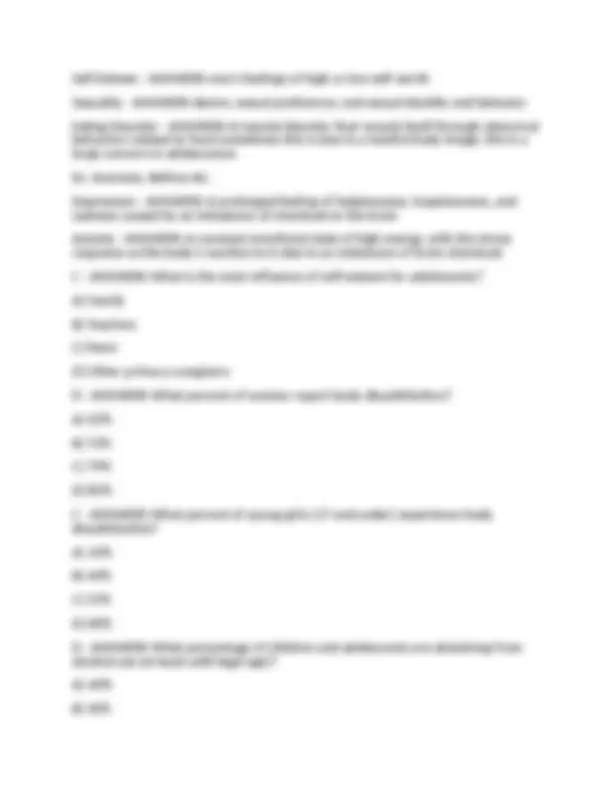
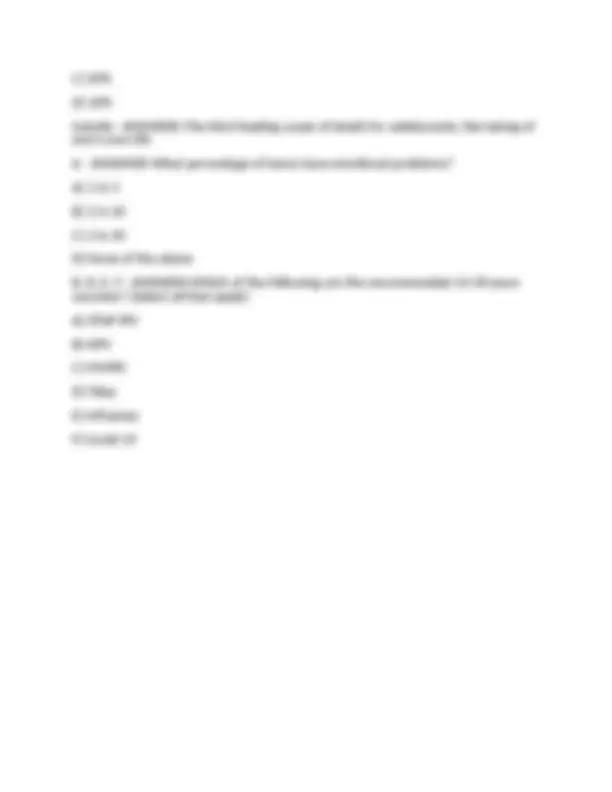


Study with the several resources on Docsity

Earn points by helping other students or get them with a premium plan


Prepare for your exams
Study with the several resources on Docsity

Earn points to download
Earn points by helping other students or get them with a premium plan
Community
Ask the community for help and clear up your study doubts
Discover the best universities in your country according to Docsity users
Free resources
Download our free guides on studying techniques, anxiety management strategies, and thesis advice from Docsity tutors
N1015 Midterm Questions With Complete Answers 2025 Graded A+ Latest Update 2025. N1015 Midterm Questions With Complete Answers 2025 Graded A+ Latest Update 2025.
Typology: Exams
1 / 25

This page cannot be seen from the preview
Don't miss anything!


















Health Promotion - ANSWERS-the process of enabling people to increase control over, and to improve, their health Determinants of Health - ANSWERS-The conditions (economic, social, environmental, biological....) in which people live that affect their current and future health. Principals of Health Promotion - ANSWERS-Include:
Charter (which expand Lalonde's work) Lalonde Report - ANSWERS-A foundational document that broadly defined health detriments as lifestyle, environment, human biology, and the organization of care; focuses on educating the public so that they know how to be healthy indent of investing time and money into the health care system itself Epp Report - ANSWERS-A foundational document with a socioenvironmental approach to health acknowledged the disparities and identified three major health challenges Ottawa Charter for Health Promotion - ANSWERS-A foundational document that identified the prerequisites for health; places responsibility for health on society rather than just individuals Socioenvironmental Approach to Healthcare - ANSWERS-A healthcare approach supported by the social determinants of health that looks. Beyond the individual. Human biology, environment, lifestyle, and healthcare organization - ANSWERS- What are the four key areas of the Lalonde Report? 1974 - ANSWERS-What year was the Lalonde report released? Shifting Paradigm Conference - ANSWERS-A conference in 1980 which challenged the healing paradigm of Western Medicine and gave rise to 2 ideas; self- responsibility for health and health & lifestyles are affected by social structures & conditions. Beyond Health Care Conference - ANSWERS-An international think tank conference in 1984 that brought health promotion into the political arena; it highlighted two ideas healthy public policy and healthy cities/communities projects Disadvantaged groups have poorer health, preventable disease lowers health of Canadians, and chronic diseases are increasing - ANSWERS-What three major challenges were identified by The Epp Report that were not met by the current health care practice & policies? Building healthy public policy, create supportive environment, strengthen community action, develop personal skills, reorient health services - ANSWERS- What were the 5 strategies of health promotion identified in the Ottawa charter? Social Determinants of Health - ANSWERS-Key guidelines for health promotion methods. Includes the following;
Nursing Roles - ANSWERS-Includes advocate, care manager, consultant, direct caregiver, educator, and researcher Virtual Care - ANSWERS-Any interaction between patients and/or members of their circle of care, occurring remotely, using any forms of communication or information technologies Advantages of Virtual Care - ANSWERS-The up-sides to this new system include increased efficiencies, increased accessibility, improved outcomes, reduced costs, convinces for clients, improves clients lifestyle, and flexibility in scheduling Challenges of Virtual Care - ANSWERS-The down-sides to this new system include not accessible to everyone, lack of hands-on approach, clients may not be comfortable with technology, and glitches Principals of Primary Health Care - ANSWERS-Includes;
behaviour? How to make it accessible to all?
what to learn & how to learn it. Its an effective approach if group is motivated/ well-educated and therefore often quite effective in community health setting as population seeks specific education/counseling but the educator may guide or facilitate Ability/ Readiness to learn - ANSWERS-The factors that may affect ones ability to learn such as emotional capability/readiness, intellectual (cognitive) capability/readiness, physical capability/readiness, and the learner may have the motivation but may not be ready Emotional Readiness to Learn - ANSWERS-Factors such as anxiety, grief, depression which affects a student's focus and readiness to learn Physical Readiness to Learn - ANSWERS-Factors such as pain, fatigue and immobility that distracts the student and affects their readiness to learn; teach no more than a client needs to know in these situations for their own safety Intellectual (Cognitive) Readiness to Learn - ANSWERS-The clients ability to think clearly and have the cognitive ability to learn; consider the effects of analgesia, anaesthetic, and cognitive impairment Learning Style - ANSWERS-a learner's preference for sensory-perceptual, environmental, & social factors in a teaching-learning situation; includes three main types: visual, auditory, or kinaesthetic Visual Learning - ANSWERS-Learning by seeing, reading, and watching Auditory Learning - ANSWERS-Learning by hearing and listening Kinesthetic Learning - ANSWERS-Learning by performing a task or handling items Environmental Factors - ANSWERS-Factors affecting learning style which include noise, lighting, temperature, and clutter Social Factors - ANSWERS-Factors affecting learning style which include the kind of learning activities preferred ( i.e. teacher dominated vs. independent) Sensory-Perceptual Factors - ANSWERS-Factors affecting learning style which includes a cognitive style which examines ways individuals place meaning on symbols The Nursing Process - ANSWERS-Five-step systematic method for giving patient care; involves assessing, diagnosing, planning, implementing, and evaluating Learning Objective - ANSWERS-A written statement that describes what a learner will achieve as the result of an educational experience SMART Objectives - ANSWERS-Targets that are specific, measurable, achievable, realistic and time specific Self-Efficacy - ANSWERS-One's belief in their own ability.
Social Cognitive Theory - ANSWERS-A theory by Albert Bandura which noticed persons will attempt to change in relation to health teaching if:
accurately describe some phenomena Exploratory Research - ANSWERS-A major design of research in nursing that is used to gain familiarity or achieve insights into a phenomenon and answers who & what questions Descriptive Research - ANSWERS-A major design of research in nursing that allows certain phenomena to be studied under naturally occurring conditions Quasi-Eperimental - ANSWERS-A major design of research in nursing that looks for cause & effect results, but not set up to permit a true control group; Control group, if used, may not be identical to the experimental group; done when withholding a treatment would be unethical Exploratory Research - ANSWERS-Research conducted to gather more information about a problem or to make a tentative hypothesis more specific Descriptive Research - ANSWERS-research methods that involve observing behavior to describe that behavior objectively and systematically Population - ANSWERS-any definable group that is relevant to your research question Bias - ANSWERS-A particular preference or point of view that is personal, rather than scientific. Data Collection - ANSWERS-Information collected to answer research question is called ______________ Data Analysis - ANSWERS-The process of compiling, analyzing, and interpreting the results of primary and secondary data collection. Research Mindedness/ Research Utilization - ANSWERS-Concept that implies that nurses are conscious of the contribution that research can make to both improving the quality of patient care and furthering the profession Self-management - ANSWERS-the ability of individuals and/or their caregivers to engage in the daily tasks required to maintain health and well being or to manage the physical, psychological, behavioural, and emotional sequelae of a chronic disease General Categories of Nutrients - ANSWERS-Carbohydrates, protein, fat, vitamins, minerals, and water are the 6 _______________ Carbohydrates - ANSWERS-The starches and sugars present in foods; a combination of CO2 and H2O to form glucose through photosynthesis (with the exception of lactose) B - ANSWERS-What category of nutrients is the body's preferred source of energy? A) Protein
B) Carbohydrates C) Lipids (Fats) D) Vitamins Monosaccharides - ANSWERS-The sugar molecules glucose, fructose, and galactose are classified as ____________ Disaccharides - ANSWERS-The sugar molecules lactose, maltose, and sucrose are all classified as __________ A - ANSWERS-What general category of nutrients is the most basic unit molecule? A) Carbohydrates B) Protein C) Lipids (fats) D) Minerals Simple Carbohydrates - ANSWERS-A type of carbohydrate which is made up of individual glucose or fructose molecules; can be both monosaccharides and disaccharides Complex Carbohydrates - ANSWERS-A type of carbohydrate which is made up of an elaborate chemical chain; these are polysaccharides such as starches (pasta, rice, breads etc.) Fibre - ANSWERS-A mineral crucial for bulking up food for efficient digestion Insoluble Fibre - ANSWERS-Fibre that does not dissolve in water and is not broken down by bacteria in the large intestine Ex. Wheat, rice, bran, whole grain and whole meal cereals and breads Soluble Fibre - ANSWERS-Fibre that dissolves in water or is broken down by bacteria in the large intestine Ex. Oats, oat bran, peas, beans, root vegetables and citrus fruits Glycemic Response - ANSWERS-Rise in blood sugar after carbohydrates are eaten Low Glycemic Index - ANSWERS-The rating given when the body slowly turns foods into glucose High Glycemic Index - ANSWERS-The rating given when the body quickly turns foods into glucose
Minerals - ANSWERS-One of the general categories of nutrients which are inorganic compounds thats serve structural purposes in our bones & teeth & they are found in body fluids Major (Macro) Minerals - ANSWERS-Minerals that are required in amounts greater than 100 mg Ex. Sodium Trace (Micro) Minerals - ANSWERS-Minerals that are required in amounts less than 100 mg/day Ex. Iron Water - ANSWERS-One of the general categories of nutrients which is a major part of every tissue in the body; humans can only survive a few days without it since its provides the means of transportation of nutrients throughout the body Rickets - ANSWERS-Vitamin D deficiency is called ________ Scurvy - ANSWERS-Vitamin C deficiency is called ________ Beriberi - ANSWERS-Thiamin deficiency is called ________ Night Blindness - ANSWERS-Vitamin A deficiency can cause __________ Diabetes - ANSWERS-A condition in which the body is unable to produce enough insulin, the hormone required for the metabolism of sugar Hypertension - ANSWERS-Medical term for high blood pressure Metabolic Syndrome - ANSWERS-A cluster of conditions that increase the risk of heart disease, stroke, and diabetes Hypercholesterolemia - ANSWERS-Excessive cholesterol in the blood Cancer - ANSWERS-Disorder in which some of the body's cells lose the ability to control growth Development - ANSWERS-the sequence of physical, psychosocial, and cognitive developmental changes that take place over the human lifespan Sleep - ANSWERS-a natural, necessary process which involves the natural periodic suspension of consciousness and a shift in physiologic and neurologic activity, and it is intended to be restorative Prenatal Period - ANSWERS-The period of human life that encompasses conception to birth (three trimesters)
Preconception Health - ANSWERS-The sexual health of women and men during their reproductive years while they are planning to conceive B - ANSWERS-Prenatal care is what level of health prevention? A) Primary B) Secondary C) Tertiary D) Both primary and secondary Poverty - ANSWERS-Inability to meet basic needs for food, clothing, and shelter due to being extremely poor Domestic Violence - ANSWERS-the use of force to control and maintain power over a spouse in the home False - ANSWERS-TRUE OR FALSE: Domestic violence is less likely to occur towards a woman while they are pregnant Folic Acid - ANSWERS-a vitamin of the B complex, found especially in leafy green vegetables, liver, and kidney which is essential for women who are pregnant and breastfeeding Sudden Infant Death Syndrome (SIDS) - ANSWERS-the unexplained death of a seemingly healthy baby TORCH Screening - ANSWERS-a set of blood tests for infectious agents that cause fetal abnormalities; Tests for: -Toxoplasmosis -Others/ hepatitis B -Rubella -Cytomegalovirus -Herpes Simplex Ultrasound - ANSWERS-A technique for examining a fetus in the uterus. High- frequency sound waves echoing off the fetus are used to produce an image of the fetus. Amniocentesis - ANSWERS-The definitive test for genetic abnormalities in a fetus but is invasive and has risks C - ANSWERS-Which of the following is NOT a PHYSICAL environmental hazard during the prenatal period?
emotional, or sexual well-being Shaken Baby Syndrome (SBS) - ANSWERS-The medical term used to describe the violent shaking of an infant; injuries can include brain swelling, brain damage, mental delay, blindness etc. A, C, D - ANSWERS-Which of the following are the correct levels of primary injury prevention in infants? (Select all that apply) A) Immunizations B) Breast feeding C) Child Restraints (car seats, baby gates etc.) D) Parenting Classes E) Supplements Healthy Beginnings Program - ANSWERS-A provincial universal screening program of newborns D - ANSWERS-Which of the following is an example of secondary prevention for a newborn? A) Reporting of suspected child abuse/mandatory laws in place B) Referrals & educational support services for high- risk families C) Referrals for vision, hearing, nutritional/dental problems D) All of the above A, B, C - ANSWERS-Which of the following are tertiary injury prevention methods for infants? (Select all that apply) A) Counseling & Coping for victims of Child Abuse B) Counselling Services for parents C) Treatment of Injuries D) Child Restraints (baby gates, car seats etc.) E) Infant Socialization Programs C - ANSWERS-The nurse preparing a teaching plan for a preschooler knows that, according to Piaget, the expected stage of development for a preschooler is A) Concrete operational B) Formal Operational
C) Preoperational D) Sensorimotor B - ANSWERS-The mother of a 2 year old asks the nurse about her child's cognitive development. Which response by the nurse best describes the normal cognitive development of a 2-year-old child? A) At this age children begin thinking intuitively B) Two year olds use magical thinking C) At this age children can solve concrete problems D) Two year olds use abstract thinking B - ANSWERS-Which nutrients are critical for the musculoskeletal development during infancy, childhood, and adolescences? A) Vitamins and minerals B) Protein and calcium C) Fats and carbohydrates D) Zinc and Potassium C, D, E - ANSWERS-Which factors are considered social determinants of health? (Select all that apply) A) Age B) Sex C) Income D) Education E) Discrimination F) Family History of Heart Disease Poisoning - ANSWERS-the second leading cause of injury hospital admissions for those aged 0-4 years and the 4th leading cause of death in ages 1-4 (peak incidence 1-3) Acute Poisoning - ANSWERS-Caused by a high dose of a harmful substance over a short period of time Ex. Bathroom and kitchen cleaning supplies Chronic Poisoning - ANSWERS-Caused by a low dose of a harmful substance over a long period of time; often identified only after irreversible damage is done
infants C) Iron rich foods are too advanced for a toddler's body to digest (i.e. red meat) D) A and B only E) All of the above Adverse Reaction - ANSWERS-An unusual response to food Intolerance - ANSWERS-adverse reaction to food that does not involve the immune system Allergy - ANSWERS-adverse reaction to food whereby protein fractions of a food are absorbed into the blood and produce an immunologic response; the body reacts by producing antibodies False - ANSWERS-TRUE OR FALSE: When potty training a toddler, it is okay to punish or ridicule them for having accidents so that they learn faster A - ANSWERS-During the potty training of a toddler, which skill would be acquired first? A) Daytime Dryness B) Nighttime dryness C) It is different for every child D) None of the above B - ANSWERS-What life stage is the first stage where health promotion efforts can be aimed at the child? A) Toddler B) Preschooler C) School-age D) Adolescents Streetproofing - ANSWERS-Preparing a child (at the preschool age) for the potential dangers of the street; the parent should promote safe baits and the child will learn self-protective behaviours A and E - ANSWERS-Which of the following are the recommended 4-6 years vaccines? (Select all that apply) A) DTaP-IPV B) Chicken Pox
D) Ebola E) Influenza F) Covid- C - ANSWERS-At what life stage should a child have all their deciduous teeth? A) Infant B) Toddler C) Preschooler D) School-age A - ANSWERS-The nurse preparing a teaching plan for a school aged child knows that, according to Piaget, the expected stage of development for a school aged child is A) Concrete operational B) Formal Operational C) Preoperational D) Sensorimotor D - ANSWERS-The nurse preparing a teaching plan for a toddler knows that, according to Piaget, the expected stage of development for a toddler is A) Concrete operational B) Formal Operational C) Preoperational D) Sensorimotor D - ANSWERS-The nurse is preparing a teaching plan for an infant knows that, according to Piaget, the expected stage of development for an infant is A) Concrete operational B) Formal Operational C) Preoperational D) Sensorimotor A - ANSWERS-The mother of a 7 year old asks the nurse about her child's cognitive